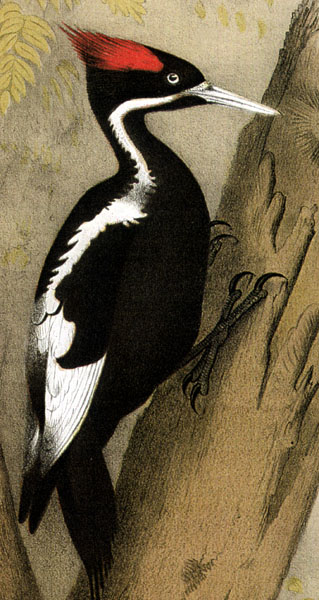The Ivory-Billed Woodpecker is probably extinct. Then again, maybe it isn’t.

It was, or is, one of the largest woodpeckers in the world, at roughly 20 inches in length and 30 inches in wingspan. It was native to the virgin forests of the southeastern United States. Logging in the nineteenth century cause enough of a loss of habitat for the bird that by the 1920’s it was thought to be almost extinct. When a pair surprisingly turned up in Florida, they were shot for specimens. By 1938, an estimated 20 individuals remained in the wild. A handful of them called a portion of old-growth forest in Louisiana home, until the Chicago Mill and Lumber Company clear-cut the forest, despite pleas from the governor and the National Audubon Society.
Luckily, the next time an ivory-billed woodpecker turned up unexpectedly, no one shot at it.

After sporadic reports of sightings of a male woodpecker in 2004, video emerged from a vast Arkansas swamp forest the following year. The tape confirmed the sighting of a live ivory-billed woodpecker. It was hailed as the birding equivalent of finding Elvis alive.

Since then there has been a handful of sightings in Arkansas and Florida, but no conclusive proof of their existence. Some ornithologists say that the birds are being confused with the Pileated Woodpecker, who is strikingly similar to the Ivory-Billed, and, notably, not extinct.

A comparison of the Ivory-Billed Woodpecker (bottom) with the Pileated Woodpecker (top). Thanks Wikipedia!
The Ivory-billed Woodpecker is sometimes referred to as the Grail Bird, the Lord God Bird, or the Good God Bird, all based on the exclamations of awed onlookers. Other nicknames for the bird are King of the Woodpeckers, and Elvis in Feathers.
In December 2008, the Cornell Lab of Ornithology announced a reward of $50,000 to the person who can lead a project biologist to a living Ivory-billed Woodpecker. The reward is still unclaimed.


2 comments for “Ivory-Billed Woodpecker”